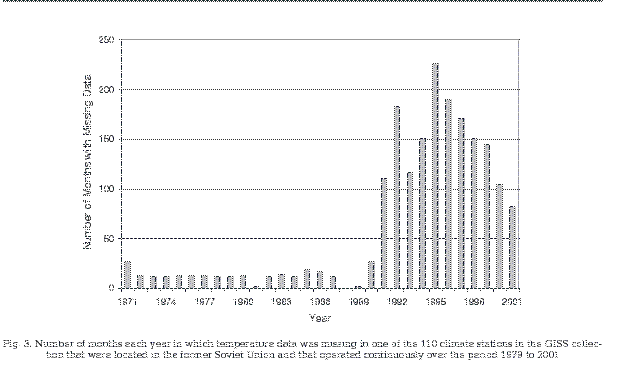JUNE 7TH 2004
"GLOBAL WARMING" FOR REAL
The almost universal belief in "global warming' is largely based on confidence in
the amalgamated surface temperature records from meteorological stations which have
been published and maintained by three main teams, two in the United States (Global
Historical Climate Network, GHCN, and Goddard Institute of Space Studies, GISS) and
Britain (University of East Anglia Climatic Research Unit, CRU).
It is admitted by everybody that the individual temperature records are subject to
various forms of bias. To begin with, they do not cover even the land portion of
the earth's surface in a random manner. Then, they are influenced by changes in the
urban environment, changes in instrumentation, monitoring procedures, and staff
training and supervision. I have published a detailed account of the difficulties
presented by these problems in my paper
"The Cause of Global Warming" Energy & Environment 2000, 11, 613-629 which is
available at
http://www.john-daly.com/cause/cause.htm
I subsequently examined the actual mean global surface temperature anomalies for the
5°x5° geographical grids upon which the IPCC global averages are based, at
http://www.john-daly.com/guests/regional.htm
and found many gaps in the system and wide variation between neighbouring grids. I
particularly noted the extraordinary increase in Russian/Siberian temperatures in
recent years, sufficient to skew the whole system.
The authors of the publicly presented temperature records claim that they have made
adequate "corrections" to their figures to allow for the various biases. A new study
by Ross McKittrick and Patrick Michaels, "A test of corrections for extraneous
signals in gridded surface temperature data" published in Climate Research 200420
159-179 shows that these "corrections" are inadequate.
McKittrick and Michaels took 218 monthly surface temperature records with continuous
published annual averages from 1979 to 2000 from the publicly available GISS
collection, distributed fairly uniformly over the land surface, and they derived a
linear trend coefficient over this period for each site. They then regressed this
trend figure against a number of factors that might influence it; measures of the
local climate, local economic activity, (income, gross domestic product [GDP] growth
rates, coal use) and data quality.
They found that the spatial pattern of trends was significantly correlated with
non-climatic factors, including economic activity and sociopolitical characteristics
of the region. They then repeated the exercise on the gridded data from the Climatic
Research Unit, as used by the IPCC, which were supposed to be "corrected" for these
factors; but they found little change. There was still a significant influence of
the non-climatic factors.
Of particular interest was their exposure of the "Soviet" factor. The mystery, that
I identified, of the very high is associated with the very
high number of missing monthly figures in the Russian/Siberian records after 1989
when, it appears, the Russian meteorological service underwent near collapse.

It seems incredible that responsible scientists can present averages based on such
unreliable data as having been "corrected" for bias. My study identified some other
probable major errors in the surface record. For instance there were the large
number of stations shut down during the two world wars.
McKittrick and Michaels attempted to make their own "corrections" to the undoubtedly
biased data that they identified. The original sample average was a temperature
increase of 0.270°C per decade from 1979 to 2000. When "economic" effects were
removed, it went down to 0.110°C per decade, Further removal of "social" effects
gave 0.063°C per decade. Finally, removal of the "soviet": effect, gave a final,
corrected value of 0.011°C per decade. This represents the real value of "global
warming" over the period 1979 to 2000.
These results apply only to the gridded land-based measurements from meteorological
stations used by the IPCC.so they apply to only 29.2% of the earth's surface. .
Oceans constitute 70.8% of the earth's surface. Biases in sea surface temperature
measurements were identified by
J R Christy, D E Parker, S J Brown, I Macadam, M Stendel & W B Norris 2001
"Differential Trends in Tropical Sea Surface and Atmospheric Temperatures since 1979
Geophysical Research Letters 28 183-186
but nothing has been done to "correct" the records as a result of this study.
Vincent Gray
75 Silverstream Road
Crofton Downs
Wellington 6004
New Zealand
Phone/Fax (064) 4 9735939
Email vinmary.gray@paradise.net.nz
"It's not the things you don't know that fool you.
It's the things you do know that ain't so"
Josh Billings